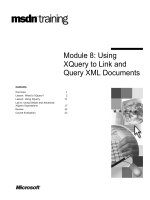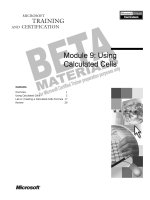Tài liệu [ Team LiB ] Using Contacts for Mail Merge Mail merge is possibly the most popular reason pptx
Bạn đang xem bản rút gọn của tài liệu. Xem và tải ngay bản đầy đủ của tài liệu tại đây (17.83 KB, 5 trang )
[ Team LiB ]
Using Contacts for Mail Merge
Mail merge is possibly the most popular reason for accessing Outlook data from Word.
Mail merge makes it easy to create address labels, personalized letters, and address
books. You can start mail merges from either Outlook or Word, and a number of options
are available to you for configuring the mail merge.
By opening Word and using the Tools, Letters and Mailings, Mail Merge menu selection
to begin the merge, you limit the number of contact fields available for use as merge
fields to common mail fields. When you start the merge from Outlook, it makes all
contact fields available to use in the merge, although you have the option to include only
the fields used in the current view.
Beginning the merge from Outlook also enables you to select a group of contacts to use
in the merge, instead of filtering your contacts using the basic filtering options available
from the Mail Merge dialog in Word.
Regardless of how you begin the mail merge, you can change the merge type or fields
used at any time. To avoid the security prompt in Outlook, you'll want to merge to
HTML-formatted messages.
Task: Start a Mail Merge from Outlook
When you begin your mail merge from Outlook, you can use its filtering capabilities to
select the contacts you want to include in your merge. Use custom views or Find to filter
your contacts, and then select the contacts you want to include in the merge.
After the contacts are filtered or selected, you're ready to create your mail merge:
1. Select the contacts you're going to merge and choose Tools, Mail Merge. This
opens the Mail Merge Contacts dialog, as shown in Figure 23.1
.
Figure 23.1. Selecting the contacts to use in Outlook often results in faster
merging in Word because the mail merge data file contains only the contacts
you're using in your merge.
2. If you selected a group of contacts before choosing mail merge, Only Selected
Contacts is enabled. Choose All Contacts in Current View if you created a filtered
view containing the contacts you want to include in the mail merge.
Use Advanced Find to find your contacts meeting specific criteria,
choose Select All, and use the Edit, Categories menu selection to add a
unique category to the contacts. Next, use the Group by Category view
to group by categories and select the category for your mail merge.
3.
4. By default, all contact fields are included in the merge. However, if you're
merging a large number of records, it's faster if you include only the fields you're
going to use. Create a view containing the fields you plan to use before beginning
the merge.
5. Select the document you want to merge to. In many cases, you'll want to keep the
default new document. However, you can merge to a predefined document, such
as a fax cover sheet or form letter.
6. If you plan to use the contact data another time or need to keep it for reference,
add a check to the Permanent File field and enter a filename. When the merge is
completed, Outlook will save the file.
7. Select the document type to which you're going to merge. Your choices are form
letters, mailing labels, envelopes, and catalog. Select the merge format you want to
use, choosing from new document, printer, and email.
If you change your mind about the document type or merge options
you want to use, you can change the merge options after the contact
data is loaded into Word.
After you choose OK to begin the merge, Outlook processes the contacts and writes them
to a file named OMM*.doc, saving it at C:\Documents and Settings\username\ Local
Settings\Temp.
If you want to save the data file, use Windows Explorer to find it. Copy
it to your My Documents folder and rename it.
Word opens with the OMM document attached as a data source and is on step 3 of the
Mail Merge Wizard. You can use the Mail Merge toolbar to add merge fields or display
the wizard by choosing Tools, Letters and Mailings, Mail Merge.
Add merge fields to your document and then complete the merge, selecting the Merge To
document type from the wizard or toolbar.
If you're new to mail merge, using the wizard to lead you through the
process the first few times is very helpful.
Should you realize that you selected contacts you don't want to include in the merge, you
don't need to redo it. Uncheck the contacts you don't want included or filter the contacts
by selecting the arrows beside the field names, as described in the next section.
Mail merging to email triggers security alerts that must to be allowed
for each address on your mail merge list if you merge to plain text
message format. When you merge using HTML-formatted messages,
you won't have to respond to the security prompts.
Starting Your Merge from Word
You can begin a mail merge from Word by choosing Tools, Letters and Mailings, Mail
Merge. Step through the Mail Merge Wizard, choosing Outlook as your data source in
step 3. Choose Select from Outlook's Contacts, and then click Choose Contacts Folder to
open the Select Contacts List Folder dialog. Select the Contacts folder and choose OK.
The Mail Merge Recipients dialog is populated with all the contacts in the Contacts
folder, which might take a couple of minutes if you have a large number of contacts.
Click on the field names to change their sort order, or set up filters by clicking the black
arrows (as shown in Figure 23.2
) and choosing from (All), (Blanks), (NonBlanks), or
(Advanced).
Figure 23.2. Remove the check from the records you don't want to include in your
merge or use the arrow buttons to filter the records. Black arrows indicate no filter;
blue arrows are used for fields where filters are set.
Choosing Advanced Filtering Options opens the Filter and Sort dialog, as shown in
Figure 23.3
. You can use this dialog to create filters, but it's generally easier to filter in
Outlook and begin the merge from Outlook rather than use the Filter and Sort dialog.
Figure 23.3. Use the Filter and Sort dialog to filter your mail merge records.
Complete the steps in the wizard and finish the mail merge.
[ Team LiB ]









